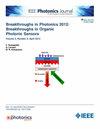宽视场高光谱成像小伪装目标抗噪检测的鲁棒双模型方法
IF 2.4
4区 工程技术
Q3 ENGINEERING, ELECTRICAL & ELECTRONIC
引用次数: 0
摘要
高光谱成像在远距离目标检测中发挥着至关重要的作用,但数据复杂性和噪声干扰给高光谱成像带来了挑战。在本研究获得的高光谱图像中,被伪装的目标平均占用不到25个像素——大约占总像素的0.0007%——这强调了检测这种微小物体的极端困难。该研究提出了一种鲁棒双模型融合方法,将BP神经网络和随机森林相结合,以提高检测精度和抑制噪声。通过利用BP的非线性模式识别能力和随机森林的集成决策,该方法可以有效地识别宽视场高光谱图像中的小型伪装目标,同时保持较低的误报率。利用FS-22高光谱数据(300个光谱通道,1920 × 1920分辨率)在高噪声条件下成功探测到远距离伪装车辆。与单个模型相比,双模型在检测概率、虚警率抑制和噪声去除方面表现出优越的性能。实验结果验证了该方法在抗噪声、远程高光谱目标检测中的有效性,提高了检测的可靠性和精度。本文章由计算机程序翻译,如有差异,请以英文原文为准。
Robust Dual-Model Approach for Noise-Resilient Detection of Small Camouflaged Targets in Wide-Field Hyperspectral Imaging
Hyperspectral imaging plays a crucial role in long-distance target detection, yet challenges arise from data complexity and noise interference. In the hyperspectral images acquired for this study, the camouflaged target occupies on average fewer than 25 pixels—approximately 0.0007% of the total pixels—which underscores the extreme difficulty of detecting such minute objects. This study proposes a robust dual-model fusion approach, integrating a Back Propagation (BP) neural network and Random Forest to enhance detection accuracy and noise suppression. By leveraging BP’s nonlinear pattern recognition capabilities and Random Forest’s ensemble decision-making, the method effectively identifies small, camouflaged targets in wide-field hyperspectral imagery while maintaining low false-alarm rates. Experiments using FS-22 hyperspectral data (300 spectral channels, 1920 × 1920 resolution) successfully detected camouflaged vehicle at long distances under challenging noise conditions. The dual model demonstrates superior performance in terms of probability of detection, false-alarm rate suppression, and noise removal compared to individual models. The results validate the effectiveness of the proposed approach for noise-resilient, long-range hyperspectral target detection with enhanced reliability and accuracy.
求助全文
通过发布文献求助,成功后即可免费获取论文全文。
去求助
来源期刊

IEEE Photonics Journal
ENGINEERING, ELECTRICAL & ELECTRONIC-OPTICS
CiteScore
4.50
自引率
8.30%
发文量
489
审稿时长
1.4 months
期刊介绍:
Breakthroughs in the generation of light and in its control and utilization have given rise to the field of Photonics, a rapidly expanding area of science and technology with major technological and economic impact. Photonics integrates quantum electronics and optics to accelerate progress in the generation of novel photon sources and in their utilization in emerging applications at the micro and nano scales spanning from the far-infrared/THz to the x-ray region of the electromagnetic spectrum. IEEE Photonics Journal is an online-only journal dedicated to the rapid disclosure of top-quality peer-reviewed research at the forefront of all areas of photonics. Contributions addressing issues ranging from fundamental understanding to emerging technologies and applications are within the scope of the Journal. The Journal includes topics in: Photon sources from far infrared to X-rays, Photonics materials and engineered photonic structures, Integrated optics and optoelectronic, Ultrafast, attosecond, high field and short wavelength photonics, Biophotonics, including DNA photonics, Nanophotonics, Magnetophotonics, Fundamentals of light propagation and interaction; nonlinear effects, Optical data storage, Fiber optics and optical communications devices, systems, and technologies, Micro Opto Electro Mechanical Systems (MOEMS), Microwave photonics, Optical Sensors.
 求助内容:
求助内容: 应助结果提醒方式:
应助结果提醒方式:


